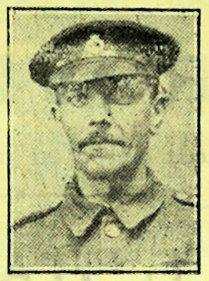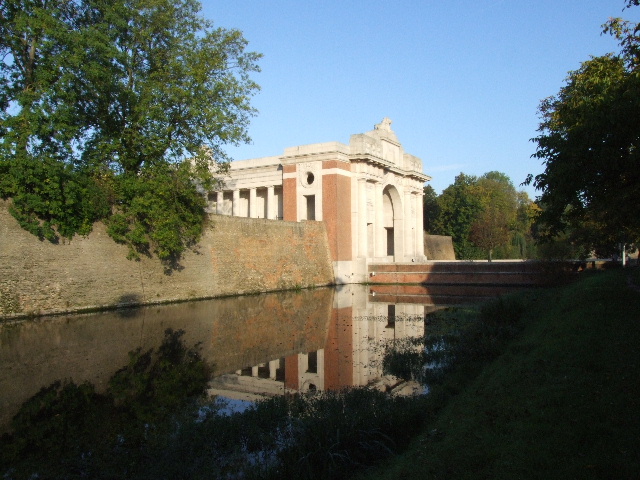Name
Thomas Wallace Arnold
Conflict
First World War
Date of Death / Age
31/07/1917
40
Rank, Service Number & Service Details
Private
269157
Hertfordshire Regiment
1st Bn.
No. 4 Coy.
Awards: Service Medals/Honour Awards
British War and Victory medals
Cemetery/Memorial: Name/Reference/Country
YPRES (MENIN GATE) MEMORIAL
Panel 54 and 56.
Belgium
Headstone Inscription
None
UK & Other Memorials
4 Co' Hertfordshire Reg' Territorials’ Memorial, Hitchin, St Mary's Church Roll of Honour, Hitchin, St. Martin’s Church Memorial, Knebworth (New), St. Martin’s Church Roll of Honour, Knebworth (New), St. Martin’s Church Framed Memorial, Knebworth (New), Not on the Knebworth Park memorials, Hertfordshire Regimental Memorial, All Saints Church, Hertford
Pre War
Thomas was born in Peckham, Surrey around 1877, probably the son of John and Elizabeth Arnold, who in 1891 were living in 16 Longhedge Street, Battersea .
He married Mary Ellen Hart on the 12th February 1899 at the St. Michaels and All Angels Church, Stoke Newington, London.
The couple had three children, Mary Ellen (1900), Thomas (1903), Elizabeth (1904). A Gardner by trade he moved to Knebworth, Hertfordshire, with his family.
In 1901, Thomas and Mary were living in Winslade Road, Hackney, between 16 and 17. Thomas working in a laundry. Their daughter Mary was just 5 months old.
In 1911 the family were living at Lake Lodge Cottage, Knebworth Park, Stevenage, Herts. with 4 children, the 3 mentioned above and Rose, who was just 1 month old. Thomas was working as a domestic gardener. The census confirmed they had been married for 12 years and that of their 4 children one had died.
Thomas worked for the Earl of Lytton for about 10 years before enlisting.
He attested into the Army at Hitchin, Hertfordshire, on the 27 May 1916, but was not called until 21st August, he was, most likely, a conscript and original service number 9080. He was recorded as requiring dental treatment, which was quite a common occurrence with recruits. At the time his home was in Knebworth Park. His wife remained at the Knebworth Park address. On 23 October 1917 she was recorded as receiving 19s and 6d separation allowance and 3s 6d from his pay on a weekly basis.
Wartime Service
Formerly service number 9080 and was renumbered to 269157 early in 1917.
Thomas served from 21 August 1916 training in England before arriving in France on the 15th December 1916 and joined the Battalion in the field on the 7th January 1917. He was admitted to hospital on the 13th March 1917, suffering from Influenza and spent most of the month recovering. He returned to the Battalion on the 28th March 1917 and was reported wounded, then missing during the Third Battle of Ypres, or Battle of Passchendaele as it more commonly known. The offensive was launched on 31st July 1917 and continued until the fall of Passchendaele village on 6th November 1917. The Battalion marched from Vlamertinghe to their assembly position arriving by midnight on the 30th/31st July 1917.
The 1st Hertfordshire Battalion were in support of an attack on the Langemarck Line and a general bombardment of the German lines commenced at 3.45am on the 31st July and and the planned assault began. It had three objectives to achieve known as Blue, Black & Green and units of the 116th Brigade easily captured the first two objectives, preparing the way for the forward companies of the Hertfordshire battalion, to take the third objective. At 05.00am the Hertfordshires left their assembly positions to attack their objective, which lay over the crest of a ridge.
As they made their way forward they came under heavy fire from both German machine guns and snipers but after eliminating a German strongpoint moved up towards St. Juliaan, which was only lightly held. The battalion crossed the Steenbeek with some difficulty and two of its supporting Tanks became bogged down in the mud. Things then went from bad to worse. A pre-arranged artillery barrage never materialised due to the guns being unable to move forward over the muddy terrain and the German barbed wire defences, which were fifteen feet deep in some places, were found to still be intact. It was soon realised that ground could only be won by section "rushes" supported by the unit’s own fire.
The Cheshire Regiment were on the right of the battalion but the Black Watch, who were due to cover the left flank, had been seriously delayed. This left the Hertfordshire Regiment seriously exposed and the Germans exploited this by bringing a hurricane of fire down upon the stricken troops. This was followed by a German counter-attack and by 10.30am it was clear that the objective could not be achieved. Casualties were very heavy with 459 men being killed, missing or wounded.
Thomas has no known grave and his name is recorded on the Menin Gate Memorial, Ypres, Belgium.
Additional Information
Acknowledgments
Adrian Dunne, David C Baines, Jonty Wild, Paul Johnson



